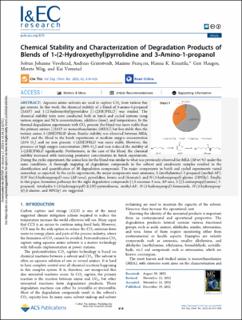Chemical Stability and Characterization of Degradation Products of Blends of 1-(2-Hydroxyethyl)pyrrolidine and 3-Amino-1-propanol
| dc.contributor.author | Vevelstad, Solrun Johanne | |
| dc.contributor.author | Grimstvedt, Andreas Magnar | |
| dc.contributor.author | Francois, Maxime | |
| dc.contributor.author | Knuutila, Hanna K | |
| dc.contributor.author | Haugen, Geir | |
| dc.contributor.author | Wiig, Merete | |
| dc.contributor.author | Vernstad, Kai | |
| dc.date.accessioned | 2023-01-18T14:37:33Z | |
| dc.date.available | 2023-01-18T14:37:33Z | |
| dc.date.created | 2022-12-20T08:34:56Z | |
| dc.date.issued | 2022 | |
| dc.identifier.citation | Industrial & Engineering Chemistry Research. 2022, 62 (1), 610-626. | en_US |
| dc.identifier.issn | 0888-5885 | |
| dc.identifier.uri | https://hdl.handle.net/11250/3044401 | |
| dc.description.abstract | Aqueous amine solvents are used to capture CO2 from various flue gas sources. In this work, the chemical stability of a blend of 3-amino-1-propanol (3A1P) and 1-(2-hydroxyethyl)pyrrolidine [1-(2HE)PRLD] was studied. The chemical stability tests were conducted both in batch and cycled systems using various oxygen and NOx concentrations, additives (iron), and temperatures. In the thermal degradation experiments with CO2 present, the blend was more stable than the primary amines [(3A1P or monoethanolamine (MEA)] but less stable than the tertiary amine 1-(2HE)PRLD alone. Similar stability was observed between MEA, 3A1P, and the blend in the batch experiments at medium oxygen concentration (21% O2) and no iron present. 1-(2HE)PRLD was more stable. However, the presence of high oxygen concentration (96% O2) and iron reduced the stability of 1-(2HE)PRLD significantly. Furthermore, in the case of the blend, the chemical stability increased with increasing promoter concentration in batch experiments. During the cyclic experiment, the amine loss for the blend was similar to what was previously observed for MEA (30 wt %) under the same conditions. A thorough mapping of degradation compounds in the solvent and condensate samples resulted in the identification and quantification of 30 degradation compounds. The major components in batch and cycled experiments varied somewhat, as expected. In the cyclic experiments, the major components were ammonia, 3-(methylamino)-1-propanol (methyl-AP), N,N′-bis(3-hydroxypropyl)-urea (AP-urea), pyrrolidine, formic acid (formate), and N-(3-hydroxypropyl)-glycine (HPGly). Finally, in this paper, formation pathways for the eight degradation compounds (1,3-oxazinan-2-one, AP-urea, 3-[(3-aminopropyl)amino]-1-propanol, tetrahydro-1-(3-hydroxypropyl)-2(1H)-pyrimidinone, methyl-AP, N-(3-hydroxypropyl)-formamide, N-(3-hydroxypropyl)-β-alanine, and HPGly) are suggested. | en_US |
| dc.language.iso | eng | en_US |
| dc.publisher | American Chemical Society | en_US |
| dc.rights | Navngivelse 4.0 Internasjonal | * |
| dc.rights.uri | http://creativecommons.org/licenses/by/4.0/deed.no | * |
| dc.subject | Solvents | en_US |
| dc.subject | Iron | en_US |
| dc.subject | Degradation | en_US |
| dc.subject | Amines | en_US |
| dc.subject | Aldehydes | en_US |
| dc.title | Chemical Stability and Characterization of Degradation Products of Blends of 1-(2-Hydroxyethyl)pyrrolidine and 3-Amino-1-propanol | en_US |
| dc.title.alternative | Chemical Stability and Characterization of Degradation Products of Blends of 1-(2-Hydroxyethyl)pyrrolidine and 3-Amino-1-propanol | en_US |
| dc.type | Peer reviewed | en_US |
| dc.type | Journal article | en_US |
| dc.description.version | publishedVersion | en_US |
| dc.rights.holder | © 2022 The Authors. Published by American Chemical Society | en_US |
| dc.source.pagenumber | 610-626 | en_US |
| dc.source.volume | 62 | en_US |
| dc.source.journal | Industrial & Engineering Chemistry Research | en_US |
| dc.source.issue | 1 | en_US |
| dc.identifier.doi | 10.1021/acs.iecr.2c03068 | |
| dc.identifier.cristin | 2095490 | |
| dc.relation.project | EU/299662 | en_US |
| dc.relation.project | EC/H2020/884266 | en_US |
| dc.relation.project | EC/FP7/608555 | en_US |
| cristin.ispublished | true | |
| cristin.fulltext | original | |
| cristin.qualitycode | 2 |
Tilhørende fil(er)
Denne innførselen finnes i følgende samling(er)
-
Publikasjoner fra CRIStin - SINTEF AS [5802]
-
SINTEF Industri [1566]

